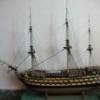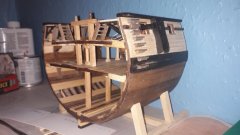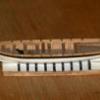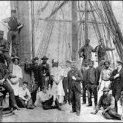MORE HANDBOOKS ARE ON THEIR WAY! We will let you know when they get here.
×
-
Posts
4,882 -
Joined
-
Last visited
Reputation Activity
-
 gjdale got a reaction from Knocklouder in 1940 Auto Repair Shop Interior by FriedClams - Finished - Diorama in 1:87
gjdale got a reaction from Knocklouder in 1940 Auto Repair Shop Interior by FriedClams - Finished - Diorama in 1:87
Just stunning Gary. As others have noted, it is only when one sees the last photo with your glasses next to it, that the scale can be truly appreciated. Bravo Sir!
-
 gjdale reacted to Siggi52 in HMS Tiger 1747 by Siggi52 - 1:48 - 60 gun ship from NMM plans
gjdale reacted to Siggi52 in HMS Tiger 1747 by Siggi52 - 1:48 - 60 gun ship from NMM plans
Hello,
the billboards are now also ready. It was't easy because they are twisted a little.
The pictures with them ready where not sharp, so I delated them.
The next things at my to do list are the windows at the quarter deck. 🤭 That means tiny carving, but one time I have to do it.
-
 gjdale reacted to giampieroricci in HMS PEGASUS by giampieroricci - Scale 1:36 - Swan-Class Sloop from plans by David Antscherl & Greg Herbert
gjdale reacted to giampieroricci in HMS PEGASUS by giampieroricci - Scale 1:36 - Swan-Class Sloop from plans by David Antscherl & Greg Herbert
Thank you, my friends!
Some step:
-
 gjdale reacted to usedtosail in Ships Wheel Project by usedtosail - FINISHED - 1:16
gjdale reacted to usedtosail in Ships Wheel Project by usedtosail - FINISHED - 1:16
I cleaned up the excess length of the treenails and sanded the planks smooth. I glued the tiller rope to the barrel and then glued the planks to the beams. I used weights to hold them down while the glue is drying.
-
 gjdale reacted to wefalck in 1940 Auto Repair Shop Interior by FriedClams - Finished - Diorama in 1:87
gjdale reacted to wefalck in 1940 Auto Repair Shop Interior by FriedClams - Finished - Diorama in 1:87
That's for a change a real diorama in the true sense of the word and not just a scenic display on a base-board !
The close-up photographs let you forget how small it is in reality - one only realises it on the last picture.
The lighting inside and outside looks very convincing.
-
 gjdale reacted to FriedClams in 1940 Auto Repair Shop Interior by FriedClams - Finished - Diorama in 1:87
gjdale reacted to FriedClams in 1940 Auto Repair Shop Interior by FriedClams - Finished - Diorama in 1:87
Greetings fellow modelers.
The last item to finish on this diorama is the exterior (through the windows) lighting and the wiring.
A styrene bracket overhangs the end of the building and LEDs are glued to the underside.
There are four warm white 5050 diodes and a single 0805. The 0805 fills in the area above the door.
This model is a lot like real estate – it looks OK until you walk around back.
The black smeared all over the seams is a PVA and acrylic paint mixture and keeps the light from shining through the cracks. In fact, I've painted the back side of the thin plastic door with the goo to prevent it from glowing as the bright light makes it almost translucent.
Originally I had intended on using an industrial/commercial scene, but decided instead on an image with colors that would feel more like a sunny day and contrast with the drab interior. The scene also needed to be a subject that could be wrapped 90 degrees through the corner which would be difficult to do with close up buildings. The line-of-sight created by the window positioning necessitates this continuous scene because it allows for viewing positions where the side wall and the back wall can be seen at the same time through a single window. So two separate scenes (one out the rear window and one out the side) can't be used.
The trimmed-to-fit image is attached to the side wall and the back gets folded in after the dio module is inserted. The flare of the lower portion of the photo keeps the viewer from seeing the inside bottom of the shadowbox. The red wire along with an identical one on the bottom holds the dio in place up tight within the face frame inset.
Two latching push buttons are recessed into the bottom - one for the interior and one for the exterior. This recess gives me the option to set the shadowbox down on a horizontal surface if I chose not to wall hang it.
The lighting is controlled in 3 main groups with each group having its own PWM (Pulse Width Modulator), so I can adjust their light levels up or down if need be. The groups are the 5 exterior lights, four pendant lights and two mezzanine lights. The bench light and pit light are separate with a fixed output.
Here is the final result. None of the images are focus stacked and the star-like rays coming from the lights are due to the use of a wide angle lens, a very small aperture and long exposure times in attempt to gain the greatest depth of field. Also, they are not HDR composites although I did open up the shadows in software on some of the images which gives them an HDRish look.
All lights on.
Interior lights only.
Exterior only.
All
Interior only.
Exterior only.
Thanks to all for stopping to take a look and for the likes. And I especially want to thank everyone who left comments. Your encouragement, suggestions and input made this a better model than it otherwise would have been – and much more enjoyable as well. Thank you so much.
Be safe and stay well.
Gary
-
 gjdale reacted to BobG in Inches or mm?
gjdale reacted to BobG in Inches or mm?
I wish the USA would convert to metric but I doubt it will ever happen and, most certainly at my age, I'll never see it. So, I guess it won't matter much in the end since we'll all end up 6 feet or 1.8288 meters under!
-
 gjdale got a reaction from BobG in Inches or mm?
gjdale got a reaction from BobG in Inches or mm?
At the end of the day, they are just numbers so it doesn’t really matter which you use. Where it does make a difference is in tooling - for example a mill or lathe, which will have their lead screws calibrated in either one system or the other (your choice on purchase). In that case, you may need to convert from one measurement system to the other, but then again, if you have a digital readout it again just becomes a matter of dialling in the the right number.
-
 gjdale reacted to Rustyj in HMS Winchelsea 1764 by Rustyj - FINISHED - 1:48
gjdale reacted to Rustyj in HMS Winchelsea 1764 by Rustyj - FINISHED - 1:48
Good ones I'm sure!
Should we be talking about rhythm method?😉
If I had to make these for a living I'd have to charge so much It'd cover the cost Chuck's next model!
Making these was a real pain in the.........hands. 😂
Well while I was at it I figured I should make the larger ring bolts for the deck. There are 8 of them and Chuck used a #31 drill bit. I did not have a #31 drill bit so I looked up what size it is and found it to be 0.120. The closest I had was a 1/8" bit that is 0.125". Close enough for me.
So I started to make them with the 24 ga. wire when I remembered that they needed to be made out of 22 ga. The one on the left is the 24 ga. You can see it is a noticeable difference.
And here is the deck with the ring bolts installed. Nothing fancy just followed the plans.
-
 gjdale reacted to Glen McGuire in SY Aurora by Glen McGuire - FINISHED - 1/500 - BOTTLE
gjdale reacted to Glen McGuire in SY Aurora by Glen McGuire - FINISHED - 1/500 - BOTTLE
The bend on the runners came out nice and uniform. It was a bit different than plank bending since there was no hull to shape it against and the bend needed to be the same on each end. But the simple fact that there are only 2 instead of 50 means it was waaaaaay easier than the usual planking stage for a ship!
For the framework, the challenge was trying to figure out how to clamp everything while the glue dried without deforming the bend in the runners. Thank goodness for a garage full of miscellaneous junk! In the end, I’m happy with how the basic frame turned out.
-
 gjdale reacted to EdT in Young America 1853 by EdT - FINISHED - extreme clipper
gjdale reacted to EdT in Young America 1853 by EdT - FINISHED - extreme clipper
Richard, I would urge you to look at the Sherline sensitive drilling attachment to make drilling with the mill easier. If this is the "jiggly" attachment you refer to, I am surprised. It is by far the most used device on my mill, allowing me to lower the drill by hand in a controlled, but still precise way. Drilling using the Z-axis wheel is not a good idea. Drilling pressure is difficult to control in this way. It puts heavy force on the drill bit that often results in breakage of small drills. The hand-controlled method is much better. If you do not have the drilling attachment, the link below shows it.
https://www.sherline.com/product/1012-532-sensitive-drilling-attachment/
Ed
-
 gjdale reacted to yvesvidal in HMS Bellona by yvesvidal - FINISHED - CAF Model - 1:48
gjdale reacted to yvesvidal in HMS Bellona by yvesvidal - FINISHED - CAF Model - 1:48
One side done:
Now, I have to brush the resin on the inside and do some sanding to make it silky smooth:
Yves
-
 gjdale reacted to Moonbug in HMS Pegasus 1776 by Moonbug - Amati Models - 1:64
gjdale reacted to Moonbug in HMS Pegasus 1776 by Moonbug - Amati Models - 1:64
Thanks a lot Greg - appreciate the look-in!
I also got a chance to get rolling on the guns this week. I started out with a test rig of one gun. Yes, I know the eye bolt is way too close to the rear of the carriage, but this gun is safely hidden under the aft deck and that will never be seen - hence the "test area."
Then the all too familiar assembly line process begins. I honestly have no idea from where these small hooks are leftover - but I'm putting them to use again. Eye bolts are all painted, two of the three sizes of rope are from @Chuck's Syren shop as are the 3/32 boxwood blocks.
I did have to drill out the boxwood blocks to a slightly larger diameter hole to accommodate the rope. Most gun rigging I've seen always comes across as a little bit chunky to me when it comes to the bocks, so I wanted to use the smallest blocks I could get away with that are still manageable with a rope that maintains some realism. 64 hooks tied with the .10 rope, 32 of which are tied to the .45 rope to create the out-haul tackle. Of course the ultimate goal here is to get all the rigging to lay in a quasi-natural looking state.
As an additional note on the above test rig: I added a tiny dab of glue to adhere the breeching ropes to the sides of the wheels both for aesthetics and ease of mounting. I have not yet made a final decision on whether or not I'll do the in-haul train tackle. I'm pretty sure I don't want to rig them all, and I kind of dig what Dan did with his Vulture where he rigged one train tackle as an example. But I'm not sure my brain can live with that lack of symmetry. We shall see. More to come.
-
 gjdale reacted to Moonbug in HMS Pegasus 1776 by Moonbug - Amati Models - 1:64
gjdale reacted to Moonbug in HMS Pegasus 1776 by Moonbug - Amati Models - 1:64
A quick update on scuppers. I decided to fill them in after all. After a pretty exhaustive search on random little things lying around the house and shipyard, I settled on speaker wires. After finding the closest size, I just stripped out the wiring and used the insulation. I did have to widen the hole a bit with a dental pick at the end of this process.
-
 gjdale got a reaction from Edwardkenway in HMS Sphinx 1775 by mtaylor - FINISHED - Vanguard Models - 1:64
gjdale got a reaction from Edwardkenway in HMS Sphinx 1775 by mtaylor - FINISHED - Vanguard Models - 1:64
Great work on the paint job Mark. Even the “wall side” looks good to me.
-
 gjdale got a reaction from Old Collingwood in HMS Sphinx 1775 by mtaylor - FINISHED - Vanguard Models - 1:64
gjdale got a reaction from Old Collingwood in HMS Sphinx 1775 by mtaylor - FINISHED - Vanguard Models - 1:64
Great work on the paint job Mark. Even the “wall side” looks good to me.
-
 gjdale got a reaction from mtaylor in SY Aurora by Glen McGuire - FINISHED - 1/500 - BOTTLE
gjdale got a reaction from mtaylor in SY Aurora by Glen McGuire - FINISHED - 1/500 - BOTTLE
Ah - that's good then - a whole 1/16" to spare. What could possibly go wrong? 😁
I'm still a couple of weeks away from starting my Amati Hannah - gotta get this Capstan Project finished first (thanks for looking in).
-
 gjdale got a reaction from Ian_Grant in SY Aurora by Glen McGuire - FINISHED - 1/500 - BOTTLE
gjdale got a reaction from Ian_Grant in SY Aurora by Glen McGuire - FINISHED - 1/500 - BOTTLE
Glen, I might be pointing out the obvious here, but.......
Your bottle neck opening is 11/16".
Your scale model breadth is 3/4" (ie 12/16")
Do we have a problem?
-
 gjdale got a reaction from Glen McGuire in SY Aurora by Glen McGuire - FINISHED - 1/500 - BOTTLE
gjdale got a reaction from Glen McGuire in SY Aurora by Glen McGuire - FINISHED - 1/500 - BOTTLE
Ah - that's good then - a whole 1/16" to spare. What could possibly go wrong? 😁
I'm still a couple of weeks away from starting my Amati Hannah - gotta get this Capstan Project finished first (thanks for looking in).
-
 gjdale got a reaction from DocRob in Alfa Romeo Spider Gran Touring by gjdale - FINISHED - Pocher - Scale 1:8
gjdale got a reaction from DocRob in Alfa Romeo Spider Gran Touring by gjdale - FINISHED - Pocher - Scale 1:8
The long-awaited steering hub has finally arrived, almost two months after ordering! All that was required for completion was to install the steering wheel, and then re-install the coachwork and complete the headlight wiring. I also replaced the damaged Alfa decal on the front nose. That took me no more than a few hours yesterday afternoon. Today I did a final glam photo shoot. I would have taken the model outside for this, but it’s been raining here for the last two weeks and showing no sign of easing up. Had to settle for an indoor shoot instead. Here are the final results.
One final comment. This build would not have been possible without the guidance of the wonderful supplementary instructions and photos from Paul Koo. Here is a couple of photos to show the difference. The Pocher instruction manual is on the left: 26 pages, mainly of exploded diagrams. On the right, the 16 booklets of instructions and photo essays from Paul Koo, and that’s not counting the hundreds more photos of inventory parts, completed models, and reference photos.
Thanks to all who have followed along and provided encouragement and support. I hope you have enjoyed following the build as much as I have in doing it. Now I can focus on completing my Medway Longboat for a while.
-
 gjdale got a reaction from MikeB4 in Alfa Romeo Spider Gran Touring by gjdale - FINISHED - Pocher - Scale 1:8
gjdale got a reaction from MikeB4 in Alfa Romeo Spider Gran Touring by gjdale - FINISHED - Pocher - Scale 1:8
The Wire Wheels - continued
Once the glue had cured, the screws from both outer metal rings were removed and the tyres installed. Getting the tyres on was quite a challenge, involving considerable force, the use of a large flat bladed screwdriver, and some very colourful language! Eventually we got there.
The brake drums were then attached to the inside of the four main wheels, with the two spare wheels being left “clean”. The brake drums were painted a deep blue, which will match the body fender colour later.
Here is the complete set of six wheels – about a week’s work to complete!
And here are a couple of shots of the wheels temporarily in situ:
I also took delivery this week of a replacement steering wheel. This is an aftermarket component from Model Motorcars – quite expensive but I think makes a huge difference and complements my walnut dashboard nicely. Here it is just temporarily in place for now:
That completes this phase of assembly. Next up is the body work….
-
 gjdale got a reaction from MikeB4 in Alfa Romeo Spider Gran Touring by gjdale - FINISHED - Pocher - Scale 1:8
gjdale got a reaction from MikeB4 in Alfa Romeo Spider Gran Touring by gjdale - FINISHED - Pocher - Scale 1:8
USPS last tracked the replacement Cam covers having travelled from the USPS distribution centre in LA on 16 April to LA International Airport on 18 May (32 days to travel that far!). Hopefully they are now finally boarding an aircraft on the way here.
In the meantime, I have decided to proceed with the next phase of construction.
The Transmission
Building the transmission follows essentially the same procedure as building the engine – ie, test fit and adjust all parts, then disassemble, paint, and re-assemble. Sounds straight forward but Paul Koo produced a photo essay of some 48 photographs to supplement the Pocher drawings, illustrating clearly where the problem areas are and how to fix them, as well as some good advice on assembly sequence so that you don’t “paint yourself into a corner”.
Here are all of the parts after test fitting and painting. Some sub-assemblies here have been pre-assembled (eg foot pedals and gear knob/handbrake handle).
Once all of the fit issues are taken care, the remainder of the assembly is fairly straight forward. The only part glued here is the tiny access hatch on the top forward end of the transmission. Here are some pictures of the completed assembly:
And here is the transmission fitted to the engine block. Again, no glue, the whole transmission is held in place by some tight fitting joints and two screws.
The Steering Gearbox
The Steering Gearbox is tackled next as it needs to be fitted to the engine block prior to installation in the chassis. Once again, the sequence of test fit, adjust, paint, re-assemble is followed. Another 28 photos from Paul Koo to show this relatively simple assembly! Here are the parts after test fitting and painting:
The steering system actually works, however some fettling is required to ensure that the gear will actually turn. I had to adjust the teeth on the cog gear with a file, clean up the worm gear on the shaft, and adjust the clearance in the housing to enable it to all turn freely once assembled. Here is what it looks like inside the gearbox:
And here is the completed steering gearbox:
And finally, here is the steering gearbox installed onto the engine block:
And a close-up:
The next phase will see the Main Frame assembled...
-
 gjdale got a reaction from MikeB4 in Alfa Romeo Spider Gran Touring by gjdale - FINISHED - Pocher - Scale 1:8
gjdale got a reaction from MikeB4 in Alfa Romeo Spider Gran Touring by gjdale - FINISHED - Pocher - Scale 1:8
I had never heard of the Pocher range of model car kits until a fellow modeller on MSW (Moonbug) took a diversion from building ships to building one of these (actually a Rolls Royce). After following his build, I knew I had to have one of these kits. After much searching online, I came across someone in Sydney selling the Pocher Alfa. The price seemed quite fair but he advertised “pick up only” – these kits are in large, quite heavy boxes so clearly he did not want to deal with packing and posting. As it happened, I was due to be travelling to Sydney the next weekend and would be quite close to his proximity. I told him I would definitely like to buy subject to physical inspection.
That weekend, my wife and I drove to Sydney and I visited the seller. He turned out to be a very nice old chap who had not one, but several of these kits to sell. He had bought four of them when his four boys were very young, with the intention of presenting them a finished model on each of their 21st birthdays. The youngest son was now 48 and three of the models had not even been started, including this one. Everything was still in the original sealed bags inside the box, so that was good enough for me. As I was leaving, he asked if I’d be interested in his Rolls Royce Sedanca Coupe as well. I politely declined, fearing what the Admiral might say. Anyway, as we were driving away, I cautiously mentioned to my wife the latter part of the conversation and to my great surprise, she asked if I’d like the second kit as a Christmas present. Needless to say, we turned around and bought the second kit as well.
That was in October 2016. I finally got around to making a start on this model in late February 2020.
Anyone who is familiar with these Pocher kits will know that they are famous for two things: the amazing level of detail they provide, and the equally amazing poor quality control and parts fit. Furthermore, the instruction manuals are little more than a series of exploded parts views. Having done a lot of research I came across a guy in the US by the name of Paul Koo, who has made a series of detailed instruction manuals for all of the Pocher classic car range. His DVD contains very thorough step-by-step instructions that forewarn you of all of the “problems” with each kit, and how to remedy these, BEFORE you find out the hard way. The DVDs also contain hundreds of photos showing everything from parts identification, to assembly sequences, and even how to pack the parts back into the box. There are also many reference photos from actual cars still in existence. On top of that, he carries an extensive range of spare parts that he has collected from partial models over the years. If you’re missing a part, chances are Paul can provide it. He is also an extremely nice and helpful fellow with whom it is a pleasure to do business. So much so, that I have subsequently added another two kits to my stash…….
What’s in the box?
A lot! There is so much packed into this kit, that Paul’s DVD contains 68 photos to help identify the various bags of metal parts and all of the plastic sprues. Here are a few photos from the DVD to show the contents by “layer” within the very large box. These are essential if you are to have any hope of getting everything back in the box again!
Not showing above are the two wing panels that are hidden under the final piece of cardboard at the front of the box in the last picture above.
Continued in the next post...
-
 gjdale got a reaction from MikeB4 in Alfa Romeo Spider Gran Touring by gjdale - FINISHED - Pocher - Scale 1:8
gjdale got a reaction from MikeB4 in Alfa Romeo Spider Gran Touring by gjdale - FINISHED - Pocher - Scale 1:8
The Engine Block
For this entire build, the basic sequence is to test fit the parts for each build step, adjust the fit, then disassemble, paint and re-assemble. However, before I could even start on the test fitting, I found that I had to address some significant defects in the main engine block. Whether caused by mishandling at some stage, or just through age and the plastic becoming brittle, I found a large chunk taken out from one end of one half of the engine block. There was also a significant amount of clean-up required.
I was able to repair this using some Milliput epoxy putty. I also used some Tamiya white putty to fill some of the mold marks.
There is very little glue used in the construction of these models. A lot of the parts are screwed together using some very small screws. However, the holes in the plastic are invariably too small and are prone to cracking if forced. On the engine block and the component parts all of the screw holes were first drilled out using a 1.2mm drill and then tapped by screwing in the screw by itself first. This puts a thread into the plastic and makes it significantly easier to assemble. Additionally, a lot of screw holes are misaligned and needed to be moved or otherwise modified. Thank goodness for Paul’s instructions here – he identifies every single one of these misalignments and shows photographs of how to adjust the fit. Once this had been done, all of the component parts could then be disassembled in preparation for painting. There were a few components that made up into sub-assemblies that were able to be glued together prior to painting, however most were stripped back down to individual parts. Here are the parts ready for painting.
I’ll be breaking out the airbrush for this project, so I decided to take a diversion and build a collapsible spray booth so that I could spray inside. As I’m using Vallejo acrylic paints, I don’t need to worry about ventilation, so the booth is just to protect from overspray. It is built of poster board and “hinged” with a tape similar to duct tape, so that the whole thing will fold flat for storage is as light as a feather. In use, it fits on a small portable table that sits at 90-degrees to my main workspace, so it is quite convenient. The top of the spray booth can also be folded back to allow more light on the work surface.
I’m using Vallejo Metal Colour for painting these parts and Vallejo specifies a gloss black primer coat for these. So here are the parts with a coat of primer. The stand is something I picked up from Hobby Zone. It is actually a box construction. The top with the holes comes off and then the “arms” (10 of them supplied) are all stored within the box when not in use. The arms are a stiff but flexible plastic with an alligator clip at the end. It’s quite a neat little set up.
Continued in the next post....
-
 gjdale got a reaction from MikeB4 in Alfa Romeo Spider Gran Touring by gjdale - FINISHED - Pocher - Scale 1:8
gjdale got a reaction from MikeB4 in Alfa Romeo Spider Gran Touring by gjdale - FINISHED - Pocher - Scale 1:8
The main engine block in the street variant of this car was aluminium with a cast iron cylinder head. I sprayed the majority of the engine components with Vallejo Dull Aluminium and then went back and hand painted the simulated bolt heads with Vallejo Gun Metal. The main block was sprayed with a two-tone effect using Dull Aluminium and Black for the cylinder head. Everything was then given a coat of Metal Varnish to finish. Here are a few photos to show the overall painting, along with some close ups of the various components.
These components are now ready for assembly.









